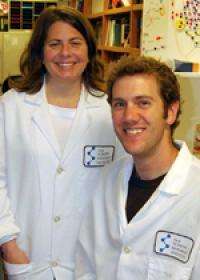New screening technique yields elusive compounds to block immune-regulating enzyme

Scientists at The Scripps Research Institute have found the first chemical compounds that act to block an enzyme that has been linked to inflammatory conditions such as asthma and arthritis, as well as some inflammation-promoted cancers.
The new study, published recently by the journal ACS Chemical Biology, describes new compounds that inhibit an important enzyme called PRMT1 (protein arginine methyltransferase 1). The new inhibitors will be useful to scientists who study PRMT1-related biological pathways in cells and who are developing drug treatments for PRMT1-related inflammatory conditions and cancers.
Standard screening techniques had been unable to distinguish between compounds that inhibit PRMT1 and those that inhibit other common PRMT family enzymes. In the new study, scientists from several Scripps Research laboratories collaborated to devise the first PRMT1-specific screening technique. "We were able to target a screening probe to a specific amino acid found on PRMT1, but not on most other PRMT enzymes," said the study's principal investigator Scripps Research Assistant Professor Kerri A. Mowen.
Mowen has been studying PRMT1 since her graduate school days, and, like others in the field, has been acutely aware of the need for selective PRMT1 inhibitors. The enzyme modifies the functionality of proteins by attaching a methyl group to their arginine amino acids; as such, it is involved in some of the most basic processes in cells. For example, Mowen and her colleagues showed in 2004 that PRMT1 helps drive the production of the key immune-stimulating proteins interferon-gamma and interleukin-4.
But although PRMT1 was known to be responsible for nearly all the arginine methylation that goes in mammalian cells, no one had been able to develop selective PRMT1 inhibitors, since the 10 other PRMT enzymes are nearly identical, structurally and biochemically. Even the removal of PRMT1's gene from lab mice as an alternative way to study its functions was problematic, since mouse embryos can't survive without the protein.
Inspiration Close By
The inspiration for the new PRMT1-selective screening technique came from research performed in the neighboring laboratory of co-author Benjamin F. Cravatt III, who chairs the Scripps Research Department of Chemical Physiology. As reported in 2010 in the journal Nature, Cravatt and his team screened tens of thousands of human and mouse proteins for the presence of hyper-reactive cysteine amino acids, which almost certainly mark functional sites on those proteins. PRMT1 was found to be one of the reactive-cysteine-containing proteins—and all but one other, comparatively rare PRMT enzyme was known to lack that cysteine.
"We took that discovery a step further, and we were able to find a probe that specifically would recognize that cysteine in PRMT1," said Mowen, who was one of Cravatt's collaborators on the 2010 study.
She and her colleagues first verified that the reactive cysteine in PRMT1 is in the active site of the enzyme. They then found a fluorescent probe that would bind to that cysteine. If a test compound acted as an inhibitor by fastening to PRMT1's active site, it should interfere with the probe's binding, and the probe's fluorescence-based signal therefore should be lower. By contrast, if a test compound failed to bind to PRMT1's active site, the probe should bind normally and its signal should remain elevated.
"We were able to verify, using available non-specific inhibitors of PRMT enzymes, that they did indeed bind to PRMT1 and prevent the probe from binding, and that was the proof-of-concept that enabled us to go ahead with a screen," said Myles B. C. Dillon, a graduate student in Mowen's lab who was lead author of the study.
Exploring Libraries of Potential
Dillon and Mowen turned to collaborator Scripps Research Professor Hugh Rosen, curator of a library of 16,000 chemical compounds known as the Maybridge Hitfinder Collection. By applying these compounds, one by one, along with the probe molecule, to solutions of PRMT1, the team was able to determine the compounds' abilities to bind PRMT1's active site and thus act as inhibitors. Importantly, the setup was simple enough to be adapted, with Rosen's help, as an automated, "high-throughput" technique, capable of screening thousands of compounds.
In this way, the scientists were able to sift through the compound library to find two candidate PRMT1-selective inhibitors. "They have good efficacy and specificity, and we might be able to modify them to make them even better," said Dillon.
Mowen, Dillon, and their colleagues now have a National Institutes of Health (NIH) grant to use their screening technique with a 300,000-compound NIH library, also curated at Scripps Research. "Once we get the results from this larger screen, we'll consider our best inhibitor compounds and decide which ones to start optimizing," said Dillon.
To Mowen, the success of the project owes much to the collaborative spirit at Scripps Research. "Many labs here are developing cutting-edge technologies that empower other labs' work, and certainly we were able to benefit from that," she said. "It's a very supportive, synergistic environment."
More information: "Novel Inhibitors for PRMT1 Discovered by High-Throughput Screening Using Activity-Based Fluorescence Polarization," pubs.acs.org/doi/pdf/10.1021/cb300024c
Provided by The Scripps Research Institute















